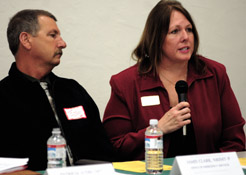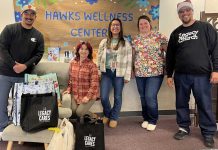
County enlists faith-based organizations for emergency
preparedness
San Benito county agencies partnered with the American Red Cross
to host a summit on Emergency Preparedness for faith-based
organizations in the county Tuesday. The workshop was part of an
ongoing series over the last three years in which Public Health
Services staff work to prepare different segments of the population
for an emergency.
San Benito county agencies partnered with the American Red Cross to host a summit on Emergency Preparedness for faith-based organizations in the county Tuesday. The workshop was part of an ongoing series over the last three years in which Public Health Services staff work to prepare different segments of the population for an emergency.
“Our world has become different over the last decade,” said Samela Perez, the public information officer for the county’s Public Health Services. She mentioned 9/11 and Hurricane Katrina as two examples.
“We need to plan and we need to plan on a local level,” she said. “We know in times of emergency people turn to their faith.”
Past summits have worked with education representatives – school nurses, principals and teachers – and with Spanish-speaking business owners.
In addition, the San Benito County Health and Human Services Agency has paired with other county agencies to conduct emergency drills. The annual flu-shot clinic sponsored by the county also serves as a drill, as staff time themselves to see how long it takes to administer vaccinations.
Nearly three dozen people attended the recent summit from such churches as St Benedict Sacred Heart Catholic Church, Sunnyslope Christian Center and Hillside Christian Fellowship, among others.
“We are really pleased at the turn out,” said Elizabeth Falade, the health officer for SBC. “We want to jointly consider ways in which we might work together.”
Falade outlined her role with the county and some of the concerns residents would face in an emergency, whether a natural disaster or a pandemic.
“Epidemics, frankly, is what really brought us here today,” she said.
The first summit in October 2006 focused on the possibility of pandemic flu. A pandemic occurs when a new, virulent strain of the flu virus to which humans do not have immunity begins to spread.
Unlike seasonal influenza, which hits the young and old hardest, a pandemic influenza would be a flu virus to which the human population has not been exposed. Without exposure, few people would have immunity to it, regardless of age, Falade explained at the first summit.
“We mitigate the impact,” she said, at the faith-based summit. “Say there’s an epidemic that’s not here yet. Our immediate goal would be to interrupt it.”
The main way to stop the spread of disease is to isolate those who are infected and, in more serious cases, quarantine anyone who has come in contact with them.”
She said the goal is to “have you think of ways we can keep our churches open.”
“Maybe we can give surgical masks out at the door. Or keep people six feet apart – even consider doing a service by television.”
Curtis Parker, a partner services manager for the American Red Cross, emphasized ways churches can play a role in emergency preparedness.
Parker, who came to San Benito from Sacramento for the event, has been a volunteer for 35 years with faith-based agencies.
“I thought there was a disconnect between what the American Red Cross is doing and what other agencies are doing,” he said.
He proposed to a group of American Red Cross staff members that they should consider ways to partner with churches.
“They said, ‘No. They just want to convert people,'” Parker said. “I told them to survey their volunteers and I would guess 75 percent are from churches.”
The survey was completed and the staff found that 77 percent of their volunteers identified a faith affiliation.
Some of the ways in which the American Red Cross has worked with churches include training congregants in first aid and basic emergency preparedness.
“We want to empower you to make sure your people are safe,” he said. “Then you can assist us. We have people that are full of compassion.”
Another way that ARC has connected with churches is reviewing facilities for use as a shelter in an emergency.
“There are no atheists in a disaster,” Parker said. “Can you take care of the physical needs of a person? If you can greet people and hug folks and have compassion, we can find a place for you.”
As part of the program, Perez invited panelists from different agencies in the community who all handle areas of emergency preparedness. Thomas Bailey came from Healdsburg to discuss his work as the regional project officer for the Office of Emergency Services Region 2, which includes San Benito County.
“We work with local agencies and the hospital,” Bailey said.
Other panelists included James Clark, who is the new manager for the San Benito County Office of Emergency Services; Lynda Maguet, the disaster services director for the American Red Cross; Brenda Gatacomb, the director of quality and risk management at Hazel Hawkins Memorial Hospital; and Patricia Ayers, of San Benito County Behavioral Health.
On each table, the participants received a box of surgical masks to use in a practice exercise after a short break. At the end, the public health staff raffled off several items for the participants. The prizes were all emergency-related items, such as a first-aid kit and a full-size family emergency preparedness kit.
Efren Gomez, the emergency services specialist for the county, talked to the group about putting together a continuity of operations plan – a plan so they could maintain services in an emergency.
“We need to assume that we may not have utilities for a few days,” he said. “We may not have services. We may be short staffed. We will all kind of be on our own.”
He provided the participants with a copy of a congregation disaster plan, put together by Santa Clara County staff.
All the panelists and speakers emphasized a need to prepare.
“Every person trained for a disaster is one less person we have to worry about,” Parker said. “When the big one hits, no one is coming. We need to be able to take care of ourselves for five to seven days.”
Resources:
– Homeland Security emergency preparedness site – www.ready.gov
– American Red Cross Monterey-San Benito Counties chapter – www.montereyarc.org or 636-2100.
– Centers for Disease Prevention and Control – www.cdc.gov or 404-639-3535
– San Benito County Public Health – http://www.sanbenitoco.org









